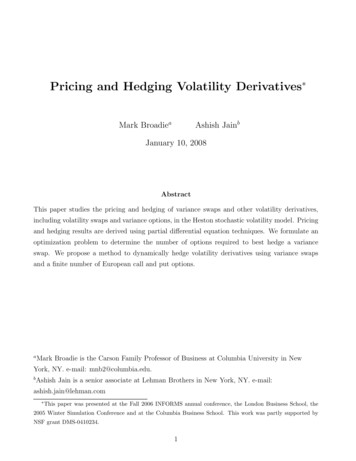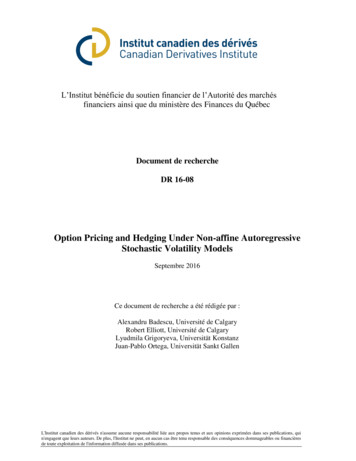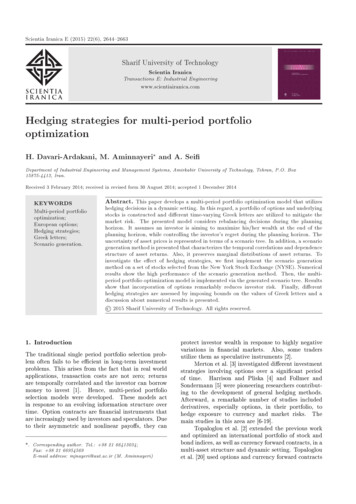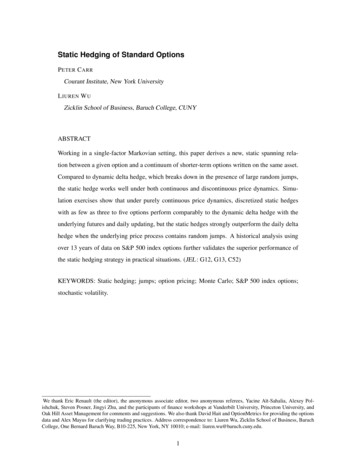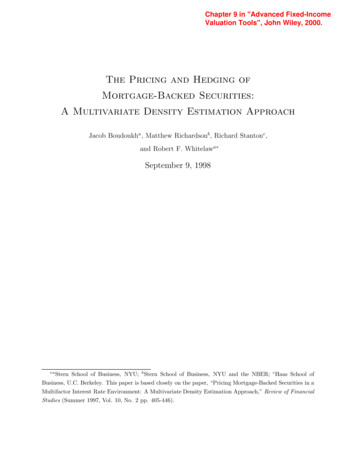
Transcription
Chapter 9 in "Advanced Fixed-IncomeValuation Tools", John Wiley, 2000.The Pricing and Hedging ofMortgage-Backed Securities:A Multivariate Density Estimation ApproachJacob Boudoukha , Matthew Richardsonb , Richard Stantonc ,and Robert F. Whitelawa September 9, 1998 aStern School of Business, NYU; b Stern School of Business, NYU and the NBER; c Haas School ofBusiness, U.C. Berkeley. This paper is based closely on the paper, “Pricing Mortgage-Backed Securities in aMultifactor Interest Rate Environment: A Multivariate Density Estimation Approach,” Review of FinancialStudies (Summer 1997, Vol. 10, No. 2 pp. 405-446).
The Pricing and Hedging ofMortgage-Backed Securities:A Multivariate Density Estimation ApproachAbstractThis chapter presents a non-parametric technique for pricing and hedging mortgagebacked securities (MBS). The particular technique used here is called multivariatedensity estimation (MDE). We find that MBS prices can be well described as a functionof two interest rate factors; the level and slope of the term structure. The interestrate level proxies for the moneyness of the prepayment option, the expected level ofprepayments, and the average life of the MBS cash flows, while the term structureslope controls for the average rate at which these cash flows should be discounted. Wealso illustrate how to hedge the interest rate risk of MBS using our model. The hedgebased on our model compares favorably with existing methods.
1IntroductionThe mortgage-backed security (MBS) market plays a special role in the U.S. economy. Originators of mortgages (S&Ls, savings and commercial banks) can spread risk across the economy by packaging these mortgages into investment pools through a variety of agencies, suchas the Government National Mortgage Association (GNMA), Federal Home Loan MortgageCorporation (FHLMC), and Federal National Mortgage Association (FNMA). Purchasersof MBS are given the opportunity to invest in virtually default-free interest-rate contingentclaims that offer payoff structures different from U.S. Treasury bonds. Due to the wide rangeof payoff patterns offered by MBS and their derivatives, the MBS market is one of the largestas well as fastest growing financial markets in the United States. For example, this marketgrew from approximately 100 million outstanding in 1980 to about in 1.5 trillion in 1993.Pricing of mortgage-backed securities is a fairly complex task, and investors in this marketshould clearly understand these complexities to fully take advantage of the tremendousopportunity offered. Pricing MBS may appear fairly simple on the surface. Fixed-ratemortgages offer fixed nominal payments; thus, fixed-rate MBS prices will be governed by purediscount bond prices. The complexity in pricing of MBS is due to the fact that statutorilymortgage holders have the option to prepay their existing mortgages; hence, MBS investorsare implicitly writing a call option on a corresponding fixed-rate bond. The timing andmagnitude of cash flows from MBS are therefore uncertain. While mortgage prepaymentsoccur largely due to falling mortgage rates other factors such as home owner mobility andhome owner inertia play important roles in determining the speed at which mortgages areprepaid. Since these non-interest rate related factors that affect prepayment (and henceMBS prices) are difficult to quantify the task of pricing MBS is quite challenging.This chapter develops a non-parametric method for pricing MBS. Much of the extantliterature (e.g., Schwartz and Torous (1989)) employs parametric methods to price MBS.Parametric pricing techniques require specification and estimation of specific functions ormodels to describe interest rate movements and prepayments. While parametric modelshave certain advantages, any model for interest rates and prepayments is bound to be onlyan approximation of reality. Non-parametric techniques such as the multivariate densityestimation (MDE) procedure that we propose, on the other hand, estimates the relationbetween MBS prices and fundamental interest rate factors directly from the data. MDE iswell suited to analyzing MBS because, although financial economists have good intuition forwhat the MBS pricing fundamentals are, the exact models for the dynamics of these funda1
mentals is too complex to be determined precisely from a parametric model. For example,while it is standard to assume at least two factors govern interest rate movements, the timeseries dynamics of these factors and the interactions between them are not well understood.In contrast, MDE has the potential to capture the effects of previously unrecognized or hardto specify interest rate dynamics on MBS prices.In this chapter, we first describe the MDE approach. We present the intuition behindthe methodology and discuss the advantages and drawbacks of non-parametric approaches.We also discuss the applicability of MDE to MBS pricing in general and to our particularapplication.We then apply the MDE method to price weekly TBA (to be announced) GNMAsecurities1 with coupons ranging from 7.5% to 10.5% over the period 1987-1994. We showthat at least two interest rate factors are necessary to fully describe the effects of the prepayment option on prices. The two factors are the interest rate level, which proxies for themoneyness of the prepayment option, the expected level of prepayments, and the averagelife of the cash flows; and the term structure slope, which controls for the average rate atwhich these cash flows should be discounted. The analysis also reveals cross-sectional differences among GNMAs with different coupons, especially with regard to their sensitivities tomovements in the two interest rate factors. The MDE methodology captures the well-knownnegative convexity of MBS prices.Finally, we present the methodology for hedging the interest rate risk of MBS basedon the pricing model in this chapter. The sensitivities of the MBS to the two interestrate factors are used to construct hedge portfolios. The hedges constructed with the MDEmethodology compare favorably to both a linear hedge and an alternative non-parametrictechnique. As can be expected, the MDE methodology works especially well in low interestrate environments when the GNMAs behave less like fixed maturity bonds.2Mortgage-Backed Security Pricing: PreliminariesMortgage-backed securities represent claims on the cash flows from mortgages that are pooledtogether and packaged as a financial asset. The interest payments and principal repaymentsmade by mortgagees, less a servicing fee, flow through to MBS investors. MBS backed byresidential mortgages are typically guaranteed by government agencies such as the GNMA1A TBA contract is just a forward contract, trading over the counter. More details are provided in Section3.2
and FHLMC or private agencies such as FNMA. Because of the reinsurance offered by theseagencies MBS investors bear virtually no default risk. Thus, the pricing of an MBS can bereduced to valuing the mortgage pool’s cash flows at the appropriate discount rate. MBSpricing then is very much an issue of estimating the magnitude and timing of the pool’s cashflows.However, pricing an MBS is not a straightforward discounted cash flow valuation. Thisis because the timing and nature of a pool’s cash flows depends on the prepayment behaviorof the holders of the individual mortgages within the pool. For example, mortgages mightbe prepaid by individuals who sell their homes and relocate. Such events lead to earlyrepayments of principal to the MBS holders. In addition, MBS contain an embedded interestrate option. Mortgage holders have an option to refinance their property and prepay theirexisting mortgages. They are more likely to do so as interest rates, and hence refinancingrates, decline below the rate of their current mortgage. This refinancing incentive tendsto lower the value of the mortgage to the MBS investor because the mortgages’ relativelyhigh expected coupon payments are replaced by an immediate payoff of the principal. Theequivalent investment alternative now available to the MBS investor is, of course, at thelower coupon rate. Therefore, the price of an MBS with, for example, a 8% coupon is roughlyequivalent to owning a default-free 8% annuity bond and writing a call option on that bond(with an exercise price of par). This option component induces a concave relation betweenthe price of MBS and the price of default-free bonds (the so called “negative convexity”).2.1MBS Pricing: An MDE ApproachModeling and pricing MBS involves two layers of complexity: (i) modeling the dynamicbehavior of the term structure of interest rates, and (ii) modeling the prepayment behaviorof mortgage holders. The standard procedure for valuation of MBS assumes a particular stochastic process for term structure movements and uses specific statistical models ofprepayment behavior. The success of this approach depends crucially on the correct parameterization of prepayment behavior and on the correct model for interest rates. We proposehere a different approach that directly estimates the relation between MBS prices and various interest rate factors. This approach circumvents the need for parametric specificationof interest rate dynamics and prepayment models.The basic intuition behind the MDE pricing technique we propose is fairly straightforward. Let a set of m variables, denoted by xt , be the underlying factors that govern interest3
rate movements and prepayment behavior. The vector xt includes interest rate variables(e.g., the level of interest rates) and possible prepayment specific variables (e.g., transactioncosts of refinancing). The MBS price at time t, denoted as Pmb,t , is a function of these factorsand can be written asPmb,t V (xt, θ)where V (xt , θ) is a function of the state variables xt, and the vector θ is a set of parametersthat describe the interest rate dynamics and the relation between the variables xt and theprepayment function. The vector θ includes variables such as the speed with which interestrates tend to revert to their long run mean values and the sensitivity of prepayments tochanges in interest rates. Parametric methods in the extant literature derive the function Vbased on equilibrium or no-arbitrage arguments and determine MBS prices using estimatesof θ in this function. The MDE procedure, on the other hand, aims to directly estimate thefunction V from the data and is not concerned with the evolution of interest rates or thespecific forms of prepayment functions.The MDE procedure starts with a similar basic idea as parametric methods, viz. thatMBS prices can be expressed as a function of a small number of interest rate factors. MBSprices are expressed as a function of these factors plus a pricing error term. The error termallows for the fact that model prices based on any small number of pricing factors will notbe identical to quoted market prices. There are several reason why market prices can beexpected to deviate from model prices. First, bid prices may be asynchronous with respectto the interest rate quotes. Furthermore, the bid-ask spreads for the MBS in this papergenerally range from1nd32to4nds,32depending on the liquidity of the MBS. Second, the MBSprices used in this paper refer to prices of unspecified mortgage pools in the marketplace (seeSection 3.1). To the extent that the universe of pools changes from period to period, andits composition may not be in the agent’s information set, this introduces an error into thepricing equation. Finally, there may be pricing factors that are not specified in the model.Therefore, we assume observed prices are given byPmb,t V (xt) t(1)where t represent the aforementioned pricing errors. A well specified model will yield smallpricing errors. Examination of t based on our model will therefore enable us to evaluate itssuitability in this pricing application.4
The first task in implementing the MDE procedure is to specify the factors that determine MBS prices. To price MBS we need factors that capture the value of fixed cash flowcomponent of MBS and refinancing incentives. The particular factors we use here are theyield on 10-year Treasury notes and the spread between the 10-year yield and the 3-monthT-bill yield. There are good reasons to use these factors for capturing the salient features ofMBS. The MBS analyzed in this paper have 30 years to maturity; however, due to potential prepayments and scheduled principal repayments, their expected lives are much shorter.Thus, the 10-year yield should approximate the level of interest rates which is appropriatefor discounting the MBS’s cash flows. Further, the 10-year yield has a correlation of 0.98with the mortgage rate (see Table 1B and Figure 1). Since the spread between the mortgagerate and the MBS’s coupon determines the refinancing incentive, the 10-year yield shouldprove useful when valuing the option component.The second variable, the slope of the term structure (in this case, the spread between the10-year and 3-month rates) provides information on two factors: the market’s expectationsabout the future path of interest rates, and the variation in the discount rate over short andlong horizons. Steep term structure slopes imply lower discount rates for short-term cashflows and higher discount rates for long-term cash flows. Further, steep term structures mayimply increases in future mortgage rates, which should decrease the likelihood of mortgagerefinancing.2.2Multivariate Density Estimation IssuesThis subsection explains the details of the multivariate density estimation technique proposedin this chapter. To understand the issues involved, suppose that the error term in equation(1) is uniformly zero and that we have unlimited data on the past history of MBS prices.Now suppose that we are interested in determining the fair price for a MBS with a particularcoupon and prepayment history at a particular point in time when, for example, the 10-yearyield is 8% and the slope of the term structure is 1%. In this case all we have to do is lookback at the historical data and pick out the price of an MBS with similar characteristics at apoint in time historically when the 10-year yield was 8% and the slope of the term structurewas 1%. While this example illustrates the simplicity of underlying idea behind the MDEprocedure, it also highlights the sources of potential problems in estimation. First of all,for reasons discussed in the last subsection, it is unrealistic to assume away the error terms.Secondly, in practice we do not have unlimited historical data, and a particular economic5
scenario, such as an 8% 10-year yield and a 1% term structure slope, may not have beenplayed out in the past. The estimation technique therefore should be capable of optimallyextracting information from the available data.The MDE procedure characterizes the joint distribution of the variables of interest, inour case the joint distribution of MBS prices and interest rate factors. We implement MDEusing a kernel estimation procedure.2 In our application, the kernel estimator for MBS pricesas a function of interest rate factors simplifies to:PTt 1P̂mb,c (rl , rl rs ) Pmb,c,t KPTt 1 K rl rl,thrlrl rl,thrl KK [rl rs ] [rl,t rs,t ]hrl rs[rl rs ] [rl,t rs,t ]hrl rs ,(2)where T is the number of observations, K(·) is a suitable kernel function and h is the windowwidth or smoothing parameter. P̂mb,c (rl , rl rs ) is our model price for a MBS with couponc when the long rate is rl and the term structure slope is rl rs . Pmb,c,t is the market priceof the tth observation for the price of a MBS with coupon c. Note that the long rate at thetime of observation t are is rl,t and the term structure slope is rl,t rs,t .The econometrician has at his or her discretion the choice of K(·) and h. It is importantto point out, however, that these choices are quite different from those faced by researchersemploying parametric methods. Here, the researcher is not trying to choose functional formsor parameters that satisfy some goodness-of-fit criterion (such as minimizing squared errorsin regression methods), but is instead characterizing the joint distribution from which thefunctional form will be determined.One popular class of kernel functions is the symmetric beta density function, whichincludes the normal density, the Epanechnikov (1969) “optimal” kernel, and the commonlyused biweight kernel as special cases. Results in the kernel estimation literature suggest thatany reasonable kernel gives almost optimal results, though in small samples there may bedifferences (see Epanechnikov (1969)). In this paper, we employ an independent multivariatenormal kernel, though it should be pointed out that our results are relatively insensitive tothe choice of kernel within the symmetric beta class. The specific functional form for theK(·) that we use is:11 2K(z) (2π) 2 e 2 z ,2For examples of MDE methods for approximating functional forms in the empirical asset pricing literature, see Pagan and Hong (1991), Harvey (1991) and Ait-Sahalia (1996). An alternative approach toestimating nonlinear functionals in the derivatives market is described by Hutchinson, Lo and Poggio (1994).They employ methods associated with neural networks to estimate the nonlinear relation between optionprices and the underlying stock price.6
where z is the appropriate argument for this function.The other parameter, the window width, is chosen based on the dispersion of the observations. For the independent multivariate normal kernel, Scott (1992) suggests the windowwidth 1ĥi ki σ̂i T m 4 ,where σ̂i is the standard deviation of the ith variable (i.e., i may denote either variable rlor rl rs ), m is the dimension of the variables, which in our case is 2, and ki is a scalingconstant often chosen via a cross-validation procedure. In our application we need to chosetwo such scaling constants, one for the long rate rl and one for the term structure sloperl rs . Note that the window width is larger when the variance of the variable underconsideration is larger in order to compensate for the fact that observations are, on average,further apart. This window width (with ki 1) has the appealing property that, for certainjoint distributions of the variables, it minimizes the asymptotic mean integrated squarederror of the estimated density function. Unfortunately, our data are serially correlated andtherefore the necessary distributional properties are not satisfied.We employ a cross-validation procedure to find the ki that minimizes the estimation error.To implement cross-validation, the implied MDE price at each data point is estimated usingthe entire sample, except for the actual data point and its nearest neighbors.3 We identifythe ki ’s that minimize the mean-squared error between the observed price and the estimatedkernel price. Once the ki ’s are chosen based on cross-validation, the actual estimation of theMBS prices and analysis of pricing errors involves the entire sample.To gain further intuition into the estimation procedure, note that equation (2) takes aspecial form; the estimate of the MBS price can be interpreted as a weighted average ofobserved prices:P̂mb,c (rl , rl rs ) whereKwr (t) PT rl rl,thr t 1 K l Krl rl,thr l TXt 1wi (t)Pmb,c,t ,[rl rs ] [rl,t rs,t ]hr r K (3) sl [rl rs ] [rl,t rs,t ]hr r sl .Note that to determine the MBS price when the interest rate factors are (rl , rl rs )the kernel estimator assigns to each observation t a weight wr (t) that is proportional to the3Due to the serial dependence of the data, we performed the cross-validation omitting one year of data,i.e., six months in either direction of the particular data point in question.7
“distance” (measured via the kernel function) between the interest rate factors at the time ofobservation t (rl,t , rl,t rs,t ) and the current interest rate factors. The attractive idea behindMDE is that these weights are not estimated in an ad hoc manner, but instead depend onthe true underlying distribution (albeit estimated) of the relevant variables. Thus, if thecurrent state of the world, as measured by the state vector (rl , rl rs ), is not close to aparticular point in the sample, then this sample price is given little weight in estimatingthe current price. Note, however, that MDE can give weight (possibly inconsequential) toall observations, so that the price of the MBS with (rl , rl rs ) also takes into accountMBS prices at surrounding interest rates. This will help average out the different errorsin equation (1) from period to period. Although our application utilizes only two factors,MDE will average out effects of other factors if they are independent of the two interest ratefactors. Thus, for any given long rate rl and a given short rate rs , there is a mapping tothe MBS price Pmb (rl , rl rs ). These prices can then be used to evaluate how MBS pricesmove with fundamental interest rate factors.While the MDE procedure has the advantage that it does not require explicit functionalspecification of interest rate dynamics and prepayment models, it does have certain drawbacks. The most serious problem with MDE is that it is data intensive. Much data arerequired in order to estimate the appropriate weights which capture the joint density function of the variables. The quantity of data which is needed increases quickly in the numberof conditioning variables used in estimation. How well MDE does at estimating the relationbetween MBS prices and the interest-rate factors is then an open question, since the noisegenerated from the estimation error can be substantial.4Another problem with MDE is that the procedure requires covariance stationarity of thevariables of interest. For example, when we use only two interest rate factors, the MDEprocedure does not account for differences in prices MBS when the underlying pools havedifferent prepayment histories. For this reason the MBS procedure is most suitable forpricing TBA securities which are most commonly used for new originations rather than forseasoned MBS. Accounting for seasoning of a mortgage or a mortgage pool’s burnout willrequire additional factors that are beyond the scope of this chapter.A few comments are in order, however, to provide some guidance on how these factorscould be accounted for when one is interested in pricing seasoned MBS. First, one could4Boudoukh, Richardson, Stanton and Whitelaw (1997) perform simulation exercises in an economy governed by two factors and some measurement error in reported prices. Within this (albeit simple) environment,the MDE methodology performs quite well.8
potentially take account of a mortgage pool’s seasoning by nonlinearly filtering out any timedependence. Estimation error aside, this filtering would be effective as long as the seasoningis independent of the other state variables. Second, in order to incorporate path dependencedue to a pool’s burnout, the only viable way would be to employ a state variable whichcaptures this dependence. For example, Boudoukh, Richardson, Stanton and Whitelaw(1997) and Richard and Roll (1989) describe several variables that might be linked closelywith burnout. Because the strength of the MDE procedure estimation of nonlinear relations,all that is required is that these variables span the appropriate state space.3Data Description3.1Data SourcesMortgage-backed security prices were obtained from Bloomberg Financial Markets coveringthe period January 1987 to May 1994. Specifically, we collected weekly data on 30-yearfixed-rate Government National Mortgage Association (GNMA) MBS, with coupons rangingfrom 7.5% to 10.5%.5 The prices represent dealer-quoted bid prices on GNMAs of differentcoupons traded for delivery on a to be announced (TBA) basis.The TBA market is most commonly employed by mortgage originators who have a givenset of mortgages that have not yet been pooled. However, trades can also involve existingpools on an unspecified basis. Rules for the delivery and settlement of TBAs are set by thePublic Securities Association (PSA) (see, for example, Bartlett (1989) for more details). Forexample, an investor might purchase 1 million worth of 8% GNMAs for forward deliverynext month. The dealer is then required to deliver 8% GNMA pools within 2.5% of thecontracted amount (i.e., between 975,000 and 1,025,000), with specific pool informationto be provided on a TBA basis (just prior to settlement). This means that, at the time of theagreed-upon-transaction, the characteristics of the mortgage pool to be delivered (e.g., theage of the pool and its prepayment history) are at the discretion of the dealer. Nevertheless,for a majority of the TBA’s, the delivered pools represent newly issued pools.With respect to the interest rate series, weekly data for the 1987-1994 period werecollected on the average rate for 30-year mortgages (collected from Bloomberg Financial5Careful filters were applied to the data to remove data reporting errors using prices reported in the WallStreet Journal. Furthermore, data are either not available or sparse for some of the GNMA coupons duringthe period. For example, in the 1980’s, 6% coupon bonds represent mortgages originated in the 1970’s, andnot the more recent issues which are the focus of this paper. Thus, data on these MBS were not used.9
Markets),6 and the yields on the 3-month Treasury bill and 10-year Treasury note (providedby the Board of Governors of the Federal Reserve).3.2Data CharacteristicsBefore describing the pricing results and error analysis for MBS using the MDE approach,we briefly describe the environment for interest rates and mortgage rates during the sampleperiod, 1987-1994.Characteristics of Mortgages (1987-1994)Since the mortgage rate represents the available rate at which homeowners can refinance,it plays an especially important role with respect to the prepayment incentive. Figure 1graphs the mortgage rate for 1987 through 1994. From 1987 to 1991, the mortgage ratevaried from 9% to 11%. In contrast, from 1991 to 1994, the mortgage rate generally declinedfrom 9.5% to 7%.7For pricing GNMA TBAs, it is most relevant to understand the characteristics of theuniverse of pools at a particular point in time. That is, the fact that a number of poolshave prepaid considerably may be irrelevant if newly originated pools have entered into theMBS market since the MBS from new originations are the one typically delivered in TBAcontracts. To get a better idea of the time series behavior of the GNMA TBAs during thisperiod, Figure 2 graphs an artificially constructed index of all the originations of 7.5% to10.5% GNMA pools from January 1983 to May 1994.8There is a wide range of origination behavior across the coupons. As mortgage ratesmoved within a 9% to 11% band between 1987 to 1991, Figure 2 shows that GNMA 9s, 9.5s,10s and 10.5s were all newly originated during this period. Consistent with the decline inmortgage rates in the post 1991 period, GNMA 7.5s, 8s and 8.5s originated while the GNMA9s–10.5s became seasoned issues. Thus, in terms of the seasoning of the pools most likelyto be delivered in the TBA market, there are clearly cross-sectional differences between thecoupons.6Bloomberg’s source for this rate is “Freddie Mac’s Primary Mortgage Market Survey”, which reportsthe average rate on 80% of newly originated 30-year, first mortgages on a weekly basis.7Note that the MBS coupon rate is typically 50 basis points less that the interest rate on the underlyingmortgage. The 50 basis point is retained to cover the servicing fee and reinsurance cost.8The dollar amount outstanding for each coupon is normalized to 100 in January 1987. Actual dollaramounts outstanding in that month were 10,172, 27,096, 10,277, 63,392, 28,503, 15,694, and 5,749(in millions) for the 7.5% – 10.5% coupons, respectively.10
Figure 2 shows that there are several reasons for choosing the TBA market during thepost 1986 time period to investigate MBS pricing using the MDE methodology. First, during1985 and 1986, interest rates dramatically declined, leading to mortgage originations for awide variety of coupon rates. Thus, the GNMA TBAs in 1987-1994 correspond to mortgagepools with little prepayment history (i.e., no burnout) and long maturities. In contrast,prior to this period, the 7.5% to 10.5% GNMAs were backed by mortgages originated in the1970’s and thus represented a different security (in both maturity and prepayment levels).Second, MDE pricing requires joint stationarity between MBS prices and the interest ratevariables. This poses a potential problem in estimating the statistical properties of any fixedmaturity security, since the maturity changes over time. Recall that the TBA market refersto unspecified mortgage pools available in the marketplace. Thus, to the extent that thereare originations of mortgages in the GNMA coupon range, the maturity of the GNMA TBAis less apt to change from week to week. Figure 2 shows that this is the case for the highercoupon GNMAs pre 1991, and for the low coupon GNMAs post 1991. Of course, when nooriginations occur in the coupon range (e.g., the GNMA 10s in the latter part of the sample),then the maturity of the available pool will decline. In this case, the researcher may needto add variables to capture the maturity effect and possibly any prepayment effects. In ouranalysis, we choose to limit the dimensionality of the multivariate system, and instead focuson the relation between MBS prices and the two interest rate factors.Characteristics of MBS Prices and Interest Rates(1987-1994)Table 1 provides ranges, standard deviations and cross-correlations of GNMA prices(Table 1A), and mortgage and interest rates (Table 1B) during the 1987-1994 period. Absentprepayments, MBS are fixed-rate annuities, and the dollar volatility of an annuity increaseswith the coupon. In co
discount bond prices. The complexity in pricing of MBS is due to the fact that statutorily mortgage holders have the option to prepay their existing mortgages; hence, MBS investors are implicitly writing a call option on a corresponding xed-rate bond. The timing and magnitude of cash flows from MBS are therefore uncertain. While mortgage .





